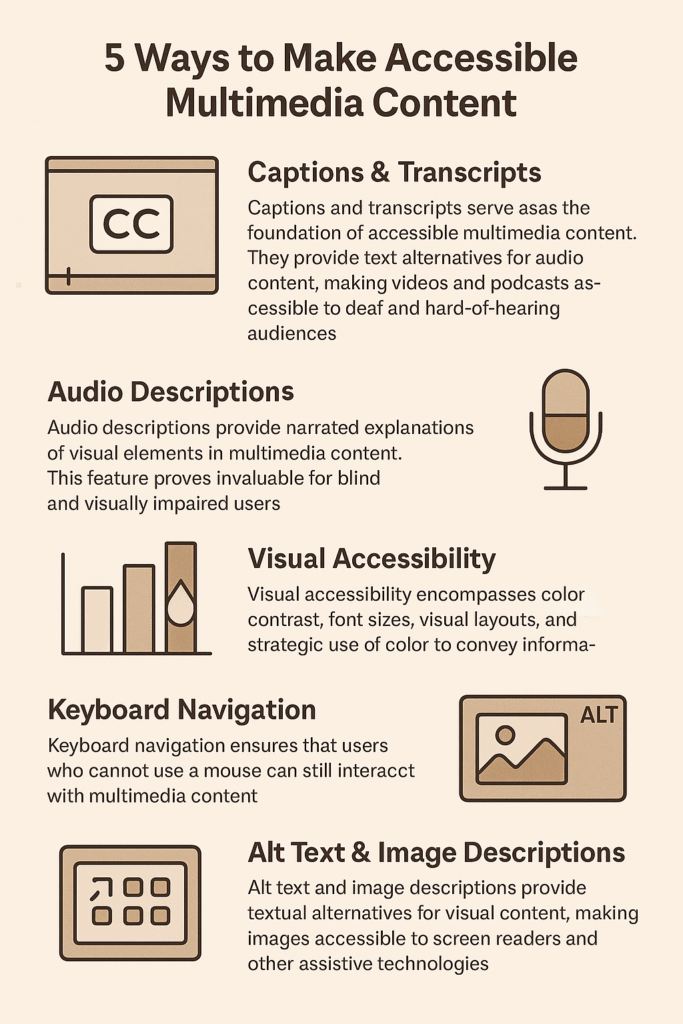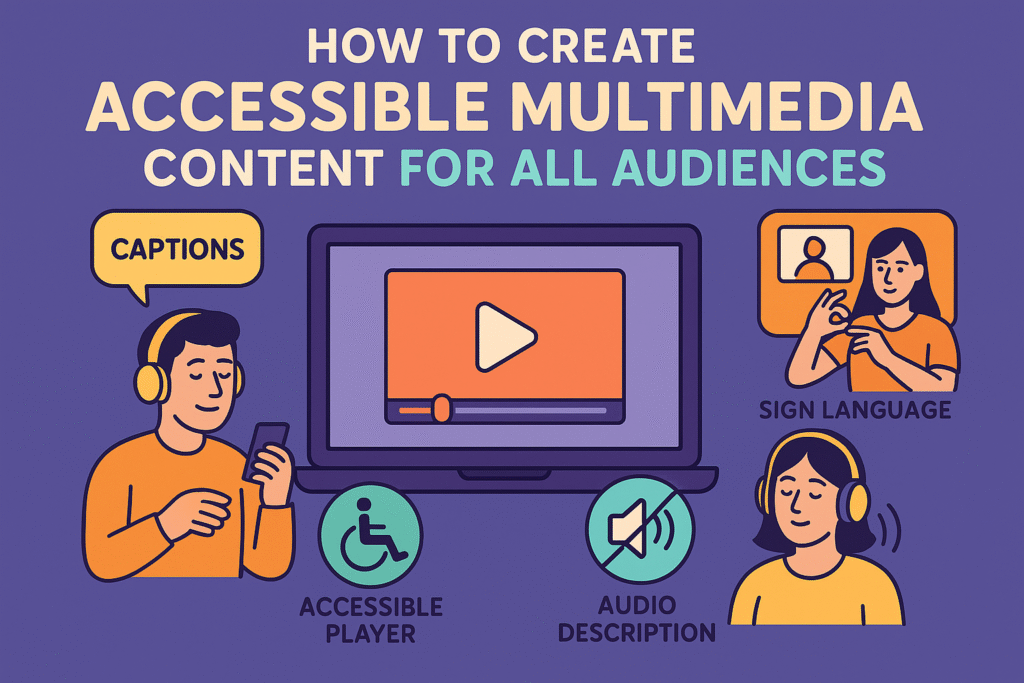Imagine Sarah, a talented graphic designer who lost her vision due to a medical condition. Despite her expertise, she struggles to access online tutorials and multimedia content that could help her adapt to new design tools. This scenario isn’t uncommon – millions of people worldwide face barriers when trying to consume digital content. Creating accessible multimedia content isn’t just about compliance; it’s about ensuring everyone can participate in our digital world.
Accessible multimedia content refers to digital media designed so that people with disabilities can perceive, understand, navigate, and interact with it effectively. This includes videos, audio files, images, interactive presentations, and web-based content that accommodate various disabilities, including visual, hearing, motor, and cognitive impairments.
In today’s digital landscape, multimedia accessibility has become crucial for businesses, educators, and content creators. With over 1 billion people worldwide living with disabilities, creating accessible multimedia content opens doors to a massive audience while demonstrating social responsibility and often meeting legal requirements.
Table of Contents
What is Accessible Multimedia Content?
Accessible multimedia content encompasses any digital media format that has been designed or modified to be usable by people with disabilities. This includes traditional media like videos and audio files, as well as interactive content such as e-learning modules, virtual reality experiences, and social media posts.
The concept extends beyond simple compliance with accessibility standards. It involves creating content that provides equivalent experiences for all users, regardless of their abilities. When we talk about creating accessible content, we’re addressing barriers that prevent people from fully engaging with multimedia materials.
Modern accessibility practices recognise that disabilities exist on a spectrum and can be temporary, situational, or permanent. For instance, someone might have difficulty hearing audio content due to a noisy environment, permanent hearing loss, or a temporary ear infection. Accessible multimedia content addresses all these scenarios through inclusive design principles.
The benefits of accessible multimedia extend far beyond serving people with disabilities. Captions help language learners understand content better, audio descriptions provide context in noisy environments, and clear navigation helps everyone find information more efficiently. These features create a better user experience for all audiences.
5 Ways To Make Accessible Multimedia Content

Captions & Transcripts
Captions and transcripts serve as the foundation of accessible multimedia content. They provide text alternatives for audio content, making videos and podcasts accessible to deaf and hard-of-hearing audiences.
Consider Maria, a marketing professional who is deaf and needs to watch a company training video. Without captions, she would miss crucial information about new procedures. With accurate captions, she can follow along seamlessly, pause to take notes, and even search for specific topics within the transcript.
Quality captions go beyond simple speech-to-text conversion. They include speaker identification, sound effects, and music descriptions. For example, “[upbeat music plays]” or “[phone ringing]” provides context that helps viewers understand the complete audio experience.
Professional transcripts offer additional benefits by improving SEO performance. Search engines can index transcript text, making your content more discoverable. According to the Web Accessibility Initiative, proper transcripts can increase video engagement by up to 40%.
Audio Descriptions
Audio descriptions provide narrated explanations of visual elements in multimedia content. This feature proves invaluable for blind and visually impaired users who cannot see important visual information.
Picture David, a university student who is blind, trying to understand a chemistry lecture video. Without audio descriptions, he would miss crucial diagrams showing molecular structures. With proper audio descriptions, a narrator explains: “The carbon atom appears at the centre, with four hydrogen atoms connected by single bonds, forming a tetrahedral structure.”
Effective audio descriptions fill gaps between dialogue and narration without overwhelming the original audio. They describe actions, settings, facial expressions, and other visual elements that contribute to understanding the content. The timing is crucial – descriptions should fit naturally into pauses in the original audio.
Modern technology has made audio descriptions more accessible through AI-powered tools, though human oversight remains essential for quality and context accuracy. The goal is to paint a complete picture through words, allowing visually impaired users to form mental images of the content.
Visual Accessibility
Visual accessibility encompasses various design elements that make multimedia content easier to see and understand. This includes colour contrast, font sizes, visual layouts, and the strategic use of colour to convey information.
Consider Robert, who has colour blindness and struggles to distinguish between red and green elements in an infographic. If the content relies solely on colour to convey important information, such as showing profit in green and losses in red, Robert would miss crucial data. Accessible design uses additional visual cues like patterns, shapes, or text labels alongside colour coding.
Colour contrast plays a vital role in visual accessibility. The Web Content Accessibility Guidelines recommend a contrast ratio of at least 4.5:1 for normal text and 3:1 for large text. Tools like WebAIM’s Colour Contrast Checker help creators verify their colour choices meet accessibility standards.
Font selection and sizing also impact accessibility. Sans-serif fonts like Arial or Helvetica typically offer better readability than decorative fonts. Adjustable font sizes allow users to customise their viewing experience based on their visual needs.
Keyboard Navigation
Keyboard navigation ensures that users who cannot use a mouse can still interact with multimedia content. This feature benefits people with motor disabilities, certain cognitive conditions, and those who prefer keyboard shortcuts for efficiency.
Imagine Lisa, who has limited hand mobility due to arthritis and relies on keyboard navigation to browse online content. When she encounters a video player that requires mouse clicks to access controls, she becomes frustrated and may abandon the content entirely. Accessible players allow her to use Tab, Space, and Arrow keys to play, pause, adjust volume, and navigate through the content.
Proper keyboard navigation follows a logical tab order, moving from left to right and top to bottom. Interactive elements should provide clear visual indicators when they receive keyboard focus, such as highlighted borders or colour changes. This visual feedback helps users understand where they are in the interface.
Skip links offer another crucial keyboard navigation feature. These hidden links become visible when users press Tab, allowing them to jump directly to main content areas without navigating through entire menus. This saves time and reduces frustration for keyboard users.
Alt Text & Image Descriptions
Alt text and image descriptions provide textual alternatives for visual content, making images accessible to screen readers and other assistive technologies. These descriptions serve as the primary way visually impaired users understand visual information.
Consider Jennifer, who uses a screen reader to browse a cooking website. When she encounters an image of a finished dish without alt text, her screen reader simply announces “image” without providing any useful information. With descriptive alt text like “Golden-brown chocolate chip cookies cooling on a wire rack,” she understands exactly what the image shows.
Effective alt text balances brevity with descriptiveness. It should convey the essential information and context of the image without being overly lengthy. For complex images like charts or infographics, longer descriptions might be necessary, sometimes provided as separate text blocks or linked descriptions.
The purpose of the image within the content determines the appropriate alt text approach. Decorative images might use empty alt text (alt=””) to avoid cluttering the screen reader experience, while informational images require detailed descriptions that capture their meaning and context.
Web Content Accessibility Guidelines
The Web Content Accessibility Guidelines (WCAG) provide the international standard for web accessibility. These guidelines organise accessibility requirements into four main principles: Perceivable, Operable, Understandable, and Robust (POUR).
The Perceivable principle ensures that users can perceive information through at least one of their senses. This includes providing captions for audio content, alt text for images, and sufficient colour contrast for visual elements.
Operable guidelines focus on user interface components and navigation that users can operate. This covers keyboard accessibility, giving users enough time to read content, and avoiding content that causes seizures or physical reactions.
Understandable requirements ensure that information and user interface operations are comprehensible. This involves using clear language, consistent navigation, and helping users avoid and correct mistakes.
Robust guidelines ensure that content can be interpreted by a wide variety of assistive technologies. This includes using valid code, providing proper markup, and ensuring compatibility with screen readers and other tools.
WCAG offers three levels of compliance: A (minimum), AA (standard), and AAA (enhanced). Most organisations aim for AA compliance, which covers the majority of accessibility barriers without requiring extensive resources. The official WCAG documentation provides detailed guidance for implementing these standards.
Conclusion
Creating accessible multimedia content represents both a moral imperative and a strategic advantage in today’s digital landscape. By implementing captions, audio descriptions, visual accessibility features, keyboard navigation, and proper alt text, content creators can reach broader audiences while improving user experience for everyone.
The journey toward accessibility doesn’t require perfection from day one. Start with one or two features, such as adding captions to videos or writing better alt text for images. Gradually expand your accessibility practices as you become more comfortable with the tools and techniques.
Remember that accessibility is an ongoing process, not a one-time checklist. User feedback, technology updates, and evolving standards require continuous attention to accessibility practices. However, the investment pays dividends through increased engagement, improved SEO performance, and the satisfaction of creating truly inclusive content.
Take action today by evaluating your current multimedia content and identifying areas for improvement. Your efforts will create a more inclusive digital world where everyone can participate fully in the information age.
FAQs
Q: How much does it cost to make multimedia content accessible?
A: The cost varies depending on content complexity and chosen methods. Basic accessibility features like captions and alt text require minimal investment, while professional audio descriptions may cost more. Many accessibility tools offer free or low-cost options for small creators.
Q: Do I need to make all my multimedia content accessible immediately?
A: While immediate implementation is ideal, a phased approach works for organisations with large content libraries. Prioritise new content and high-traffic existing materials first, then gradually address older content based on usage and importance.
Q: Can automatic tools create accessible multimedia content?
A: Automatic tools provide helpful starting points but rarely create perfect accessibility features. AI-generated captions and alt text need human review and editing to ensure accuracy and context appropriateness.
Q: How do I know if my accessible multimedia content is effective?
A: Test your content with actual users who have disabilities, use accessibility evaluation tools, and gather feedback from your audience. Regular testing with screen readers and keyboard navigation helps identify areas for improvement.
Q: Are there legal requirements for accessible multimedia content?
A: Legal requirements vary by country and organisation type. In the US, the Americans with Disabilities Act (ADA) applies to many businesses, while government entities must comply with Section 508. International organisations may need to follow EN 301 549 standards.
Q: What’s the difference between captions and subtitles?
A: Captions include all audio information (dialogue, sound effects, music) and are designed for deaf and hard-of-hearing audiences. Subtitles typically only include dialogue and are primarily for language translation or in noisy environments.
Q: How can I learn more about creating accessible content?
A: Numerous resources are available, including the Web Accessibility Initiative, accessibility-focused conferences, online courses, and professional certification programs. Many universities also offer accessibility training for designers and developers.
